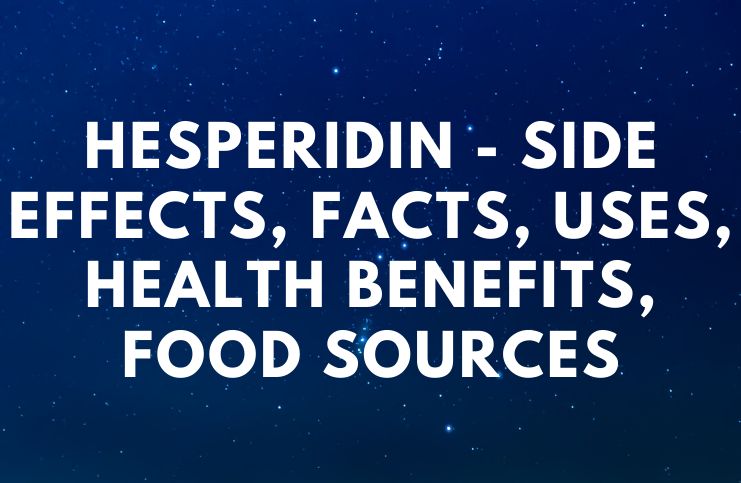Hesperidin – Side Effects, Facts, Uses, Health Benefits, Food Sources:
Facts
Hesperidin is a naturally occurring bioflavonoid, a compound in plants (primarily found in the Rutaceae family of citrus fruits) with powerful antioxidant properties and an important role in plant defense.
It was first isolated in 1828 by French chemist Lebreton from the white inner layer of citrus peels.
Bioflavonoids are found in many of the same foods that contain vitamin C, an important nutrient for the daily diet, and these super antioxidants complement vitamin C, improving its beneficial effect on the body.
The daily recommended intake of this supplement for adults is 10 to 25 mg, but individuals using it to treat some medical conditions may take 50 to 500 mg per day.
Uses and health benefits of hesperidin
Apart from its physiological antimicrobial activity, decades of research revealed its many therapeutic applications in the treatment and prevention of many human disorders. These health benefits include:
Boosts the immune system
The immune system comprises of different forms of cells fulfilling their own specialized functions, and each form of the immune cells is differentially influenced and may be simultaneously controlled by antioxidants.
As a citrus bioflavonoid, it helps the formation of the vitamin C complex, which supports healthy immune system functions.
Alleviates hemorrhoids
They result when the veins around the anus, or in the anal canal, swell when stretched under pressure. The combination of this compound and other bioflavonoids, such as diosmin, helps alleviate hemorrhoids.
Lowers LDL cholesterol
There is a strong and graded correlation between LDL cholesterol and the risk of cardiovascular disease, both in men and women.
In 2001, during a study on rats (which was published in the International Journal for Vitamin and Nutrition Research), researchers found that supplementing the animals’ high cholesterol and saturated fats diets with vitamin E and this bioflavonoid helped reduce LDL cholesterol levels in their blood.
Anti-inflammatory properties
Inflammation is usually characterized by swelling, redness, warmth, occasional pain, and some immobility.
In a 2016 study, scientists concluded that this potent flavonoid has good anti-inflammatory effects on carrageenan-induced edema, which may be related to inhibition of inflammatory mediators formation.
Antioxidant properties
In everyday life, our bodies generate free radicals. Usually, the body can handle free radicals, but if the free radical production becomes excessive, or if antioxidants are unavailable, the body becomes vulnerable to cellular damage.
The potent antioxidant function provided by this bioflavonoid allows it to protect the liver against damage caused by toxic pollutants and chemicals.
Cardiovascular health
Diseases under the heart disease umbrella include blood vessel diseases, such as heart rhythm problems (arrhythmias), coronary artery disease, and heart defects you’re born with (congenital heart defects), among others.
It is considered that this compound is responsible for the blood pressure-lowering effect of orange juice since it promotes nitric oxide production resulting in vasodilation.
Allergies
Similar to quercetin and rutin, the health benefits of this bioflavonoid include the inhibition of the release of histamine, therefore reducing allergic reactions and the symptoms of asthma.
Parkinson’s disease
Individuals with Parkinson’s disease produce less of a brain chemical called dopamine. As well as controlling the brain’s reward centers, dopamine is a powerful chemical messenger, allowing signals to be passed from cell to cell.
The studies from in vitro and in vivo have established that this bioflavonoid is able to attenuate the reduction in levels of cellular antioxidant enzymes, dopamine, and pro-survival proteins, all of which would indicate its usefulness in Parkinson’s disease treatment.
Rheumatoid arthritis
The illness can occur at any age, nevertheless, it is most common between the ages of 40 and 60 and is usually linked to the age of menopause for women.
Some studies suggest that drinking a beverage containing alpha glucosyl hesperidin for 12 weeks improves symptoms of rheumatoid arthritis.
Bone health
Osteoporosis is a progressive disease in which bones become weaker and more likely to break.
A 2016 study at the Nestle Research Center, Switzerland, concluded that calcium supplementation, in combination with this bioflavonoid, is effective at preserving bone health in postmenopausal women.
Food Sources
You can get it and other powerful bioflavonoids in your diet by consuming citrus fruits (such as oranges, lemons, limes, grapefruit), apricots, plums, and bilberry (the peel and membranes contain the highest concentration).
For example, peels from tangerines contain hesperidin the equivalent of 5-10 percent of their dry mass and in young oranges, it can account for up to 14 percent of the fresh weight of the fruit. Additionally, it can be found in vegetables such as – yellow and green peppers and broccoli, whole grains (buckwheat).
Side effects of hesperidin
There is a concern that it might increase the risk of bleeding during and after surgical procedures.
Other side effects may include stomach pain, headache, and diarrhea. In addition, it may interact with other drugs you may be taking. Talk with your healthcare specialist before taking this bioflavonoid as a supplement with any other medicine.
Moreover, it is not recommended for breastfeeding or pregnant women, due to the lack of available scientific evidence.
READ THIS NEXT:
References https://www.ncbi.nlm.nih.gov/pubmed/25394264 https://www.ncbi.nlm.nih.gov/pubmed/26751193 https://www.ncbi.nlm.nih.gov/pubmed/25617481


